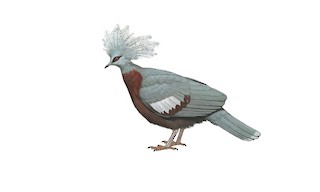
Scheepmaker's Crowned-Pigeon Goura scheepmakeri Scientific name definitions
- VU Vulnerable
- Names (23)
- Monotypic
Text last updated May 31, 2015
Sign in to see your badges
Species names in all available languages
| Language | Common name |
|---|---|
| Bulgarian | Източен коронован гълъб |
| Catalan | goura de Scheepmaker |
| Croatian | kestenjastoprsi golub |
| Czech | korunáč šedoramenný |
| Dutch | Scheepmakerkroonduif |
| English | Scheepmaker's Crowned-Pigeon |
| English (United States) | Scheepmaker's Crowned-Pigeon |
| Estonian | lõuna-kroontuvi |
| Finnish | isokruunukyyhky |
| French | Goura de Scheepmaker |
| French (Canada) | Goura de Scheepmaker |
| German | Graubug-Krontaube |
| Japanese | ミナミカンムリバト |
| Norwegian | burgunderkrondue |
| Polish | koroniec błękitny |
| Russian | Каштановогрудый венценосный голубь |
| Serbian | Šhepmakerov krunasti golub |
| Slovak | korunáč veľký |
| Spanish | Gura de Scheepmaker |
| Spanish (Spain) | Gura de Scheepmaker |
| Swedish | scheepmakerkronduva |
| Turkish | Güneyli Taçlı Güvercin |
| Ukrainian | Коронач південний |
Goura scheepmakeri Finsch, 1876
Definitions
- GOURA
- scheepmakeri
The Key to Scientific Names
Legend Overview
Field Identification
71–79 cm. Compared to formerly conspecific G. sclateri, crest appears longer, mantle and scapulars lack paler subapical bands, thus appearing less scaly, lesser coverts are uniform blue-grey, sometimes with blackish fringes, the greater coverts are more pearly white than creamy white, foreneck dark blue-grey, maroon of breast extends further back and becomes duller and greyer on belly, and undertail-coverts ash-grey or black; wing 370–380 mm, versus 341–365 mm in G. sclaterii. Similar in appearance to G. cristata but breast and belly dark purple or maroon; mantle and lesser wing-coverts greyish blue, wing-patch whitish grey; crest feathers longer and more lacy than in G. cristata; iris red; bill dark bluish grey; legs and feet purplish red. Sexes alike. Juvenile similar to that of G. cristata with creamy grey wing-patch and maroon or purple of adults replaced by chestnut.
Systematics History
Present species and G. sclaterii probably more closely related to G. cristata than to G. victoria. Formerly considered conspecific with G. sclaterii, but here split on account of its more extensive maroon-brown below, from neck to belly (2); outer greater coverts are grey vs carpal area maroon-brown, extending onto the outer greater coverts (3); dorsal plumage not scaled pale grey (ns[1]); mid-belly to vent maroon-brown vs grey (2); white wing-panel not slightly tinged yellow (ns[1]); slightly longer wing (sample size too small; ns). Monotypic.
Subspecies
Distribution
S coast of SE New Guinea from Lakekamu Basin (1), Hall Sound and Mt Epa E to Orangerie Bay; identity of most Goura populations between Fly R and Purari R apparently unknown, either this species or G. sclaterii, although there is an old specimen of the present species labelled as being from the Fly R.
Habitat
Inhabits both dry and flooded rainforests in lowland and foothills, locally to 800 m and perhaps even higher.
Movement
Sedentary. Tends to escape danger by running away, but if sufficiently alarmed, may fly and perch on limbs in midstorey, where easily shot.
Diet and Foraging
Takes seeds, berries and fallen fruit, including those knocked to the ground by other species of pigeons. Highly terrestrial; parties of 3–7 birds are commonplace, and more rarely groups of 10–30 individuals have been observed, especially in the past.
Sounds and Vocal Behavior
No known differences from G. sclaterii; a deep, hollow drumming at a heartbeat rhythm “boom-boom, boom-boom...”, somewhat reminiscent of a cassowary (2).
Breeding
One bird flushed off nest in early Aug. Breeding ecology of G. sclaterii (which see) in captivity presumably very similar to that of present species.
Conservation Status
VULNERABLE. CITES II. Population size unknown but thought to number fewer than 10,000 mature individuals. Formerly considered to be fairly common to common, but is now very rare anywhere near human settlements. Thought to occur throughout most of S lowlands E of Fly R, but is only known to remain in E of its potential distribution (Hall Sound and Mt Epa E to Orangerie Bay), having been apparently extirpated from the vicinity of Port Moresby and much of SE & S Trans-Fly region (where it is unclear if this species or G. sclaterii occurs). Within potential range of this species, rates of forest loss and degradation in last third of 20th century varied according to province, with the Gulf and Central Provinces witnessing forest loss of 6·15% and 17·59%, respectively, and rates of degradation being 13·37% and 7·56%, respectively; lowland forests, especially on flat terrain favoured by this species, are threatened by logging and development of oil-palm plantations, and although it apparently tolerates some logging, roads open up access to hunters, as does oil and gas exploration. Hunted for meat and, to a lesser extent, for its feathers, and hunted to extinction in parts of SE; however, the species is fairly difficult to hunt without a shotgun (which are essentially no longer available in New Guinea) as it flushes at considerable distance and perches high in the midstorey. It is still fairly common in the Lakekamu Basin even where hunted regularly (3). A prized aviary bird, although live export trade is apparently considerably less than in G. cristata, e.g. total of 53 birds reported to CITES as having been exported over period 1983–1988 (presumably also including at least some G. sclaterii). Protected from commercial trade and domestic use under Papua New Guinea and West Papua law. Conservation efforts initiated by Papua New Guinea Department of Environment and Conservation, and designed to involve and educate local people in forest management, should benefit the species (4).

- Year-round
- Migration
- Breeding
- Non-Breeding







































